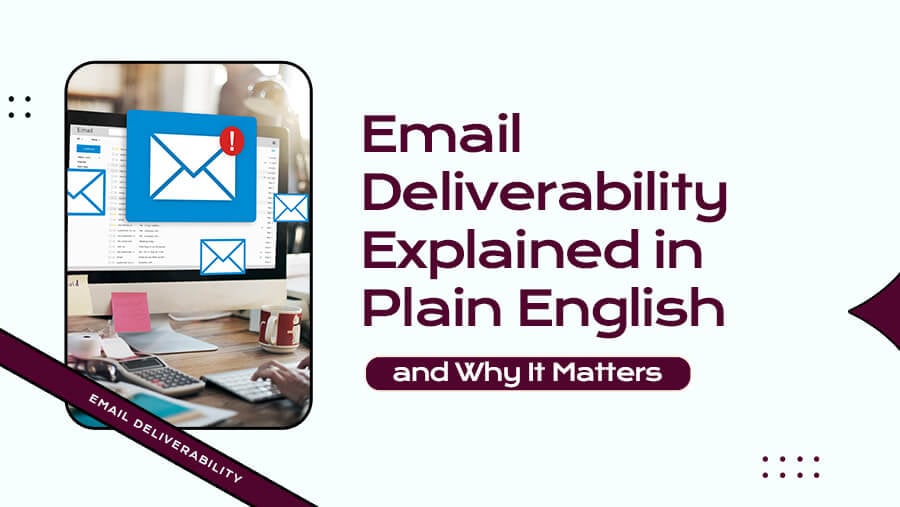
Email Deliverability Explained in Plain English (and Why It Matters)
Your email deliverability rate can directly impact how many emails reach prospects’ inboxes.
Unlike open rates or click-through rates, deliverability ensures your email lands in the primary inbox– not spam or junk folders.
With more businesses relying on digital channels to connect, understanding deliverability can make or break your outreach efforts.
What Are Email Delivery Rates?
In simple terms, email deliverability is the ability of an email to reach its intended recipient’s inbox.
Deliverability depends on several factors, from your sender's reputation to content relevance, and differs from delivery rate.
The delivery rate only considers whether an email reaches the recipient’s server, while deliverability ensures the email reaches the inbox.
What Are the Key Factors Impacting Email Deliverability?
Here’s a breakdown of factors that contribute to solid email deliverability:

Why Is Deliverability Critical for Email Campaigns?
Every email represents an opportunity to build trust and engage decision-makers. Poor deliverability reduces these opportunities and can impact revenue. When emails land in the spam folder, your message is lost.
Example Scenario:
Imagine you’re launching a new service and emailing 5,000 prospects. If only half of your emails land in the primary inbox, your potential for responses, conversions, and revenue is halved. Deliverability makes a huge difference in terms of both reach and return.
How to Improve Your Email Deliverability Rates
Here’s a step-by-step approach to optimizing deliverability for B2B campaigns:
1. Use Verified Sender Authentication
Implementing SPF (Sender Policy Framework), DKIM (DomainKeys Identified Mail), and DMARC (Domain-based Message Authentication, Reporting & Conformance) is crucial. These protocols verify your email’s legitimacy, reducing the likelihood of it being marked as spam.
Tip: Most B2B email providers offer setup assistance. If you need further guidance, contact your provider or IT team.
2. Regularly Clean Your Email List
An up-to-date email list is key. Non-engaged recipients or inactive addresses contribute to high bounce rates, which can impact your sender's reputation.
Example: You may run an audit every quarter to remove contacts who haven’t opened your emails in six months. This will maintain a list of active, engaged prospects, directly improving your deliverability rate.
3. Send Relevant Content to the Right People
Deliverability improves when recipients find your content valuable. Segment your list based on industry, job role, or previous engagement, and tailor your messaging to meet their needs.
Example: Content could focus on supply chain solutions for prospects in the manufacturing industry, while contacts in the finance industry might be interested in cost-saving strategies.
Relevant content signals to recipients (and email providers) that your emails are worth opening, boosting engagement and deliverability.
Common Mistakes that Lower Deliverability (And How to Avoid Them)
Let’s review a few common errors in your email campaigns that impact deliverability and how to avoid them.

How to Measure Email Deliverability Success
Measuring deliverability success means going beyond just checking open rates. Here are some critical metrics to track:
- Inbox Placement Rate (IPR): The percentage of emails reaching recipients' inboxes. This is your best indicator of deliverability health.
- Bounce Rate: High bounce rates suggest your list may have invalid addresses. Aim for a bounce rate below 2%.
- Spam Complaint Rate: Spam complaints signal to ISPs that your emails aren’t wanted. Keep this rate as close to zero as possible.
- Sender Score: Tools like SenderScore.org provide a reputation score for your IP address. A higher score generally means better deliverability.
Example Tool:
If you’re interested in tracking these metrics, email marketing tools like Mailchimp or SendGrid offer in-depth analytics to help monitor deliverability health.
Proactive Steps for Consistent Deliverability
Implementing good deliverability practices isn’t a one-time activity. Here’s how you can keep your B2B emails in inboxes consistently:
- Authenticate New Domains Early: Each time you introduce a new domain, authenticate it through SPF, DKIM, and DMARC to protect your sender's reputation.
- Avoid Trigger Words: Common spam words like “free,” “guaranteed,” or “limited time” can trigger spam filters. Opt for industry-relevant and value-driven language.
- A/B Test Your Emails: Try different subject lines and content styles to see what performs best. Testing minimizes the risk of spam issues and can highlight winning formats.
Make Email Deliverability Your Priority
For B2B success, ensuring strong email deliverability can’t be an afterthought. Consistently monitoring, maintaining, and optimizing deliverability can drastically improve your outreach effectiveness, brand reputation, and ROI.
By keeping a clean list, providing relevant content, and following best practices, you set your campaigns up for maximum engagement and success.
So, keep deliverability front and center in your strategy—it’s the key to driving meaningful, high-quality connections with your audience.




